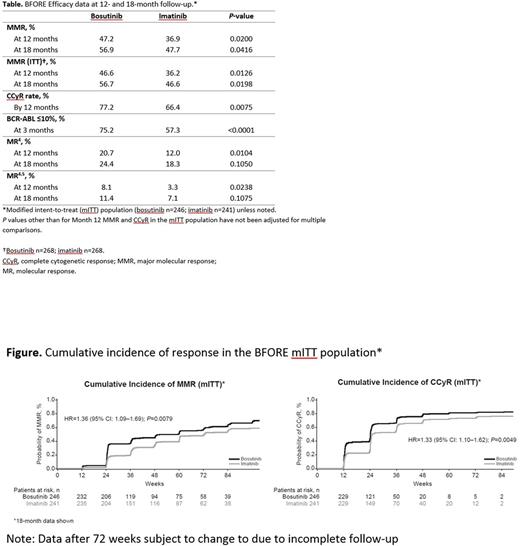Abstract
Introduction: Bosutinib is a potent SRC/ABL tyrosine kinase inhibitor approved for treatment of adults with CML resistant or intolerant to prior therapy. Here we compare the efficacy and safety of first-line bosutinib versus imatinib in patients with chronic phase (CP) CML enrolled in BFORE after ≥18 months of follow-up.
Methods: BFORE (NCT02130557) is an ongoing, multinational, open label phase 3 study that randomized 536 patients 1:1 to 400 mg QD bosutinib (n=268) or 400 mg QD imatinib (n=268 [3 not treated]). The prespecified primary endpoint was major molecular response (MMR) rate at 12 months in the modified intent-to-treat (mITT) population, defined as Philadelphia chromosome‒positive (Ph+) patients with e13a2/e14a2 transcripts, and excluding Ph- patients and those with unknown Ph status and/or BCR-ABL transcript type (mITT: BOS, n=246; IM, n=241). Efficacy results refer to the mITT population unless otherwise noted.
Results: MMR rate was higher with bosutinib versus imatinib at 18 months (56.9% vs 47.7%; P=0.042). Among all randomized patients (ITT) 18-month MMR rates were higher for bosutinib (56.7% vs 46.6%; P <0.02). Earlier analyses (Table) showed complete cytogenetic response (CCyR) rate by 12 months (77.2% vs 66.4%; P=0.0075) was significantly higher with bosutinib versus imatinib. Rates of BCR-ABL1 transcript ratio ≤10% (International Scale) at 3 months (75.2% vs 57.3%), as well as MR4 at 12 months (20.7% vs 12.0%) and MR4.5 at 12 months (8.1% vs 3.3%), were all higher with bosutinib versus imatinib (all P <0.025). By comparison at 18 months, rates of MR4 (24.4% vs 18.3%) and MR4.5 (11.4% vs 7.1%) were consistent with this trend. Also after ≥18 months follow-up, time to MMR (hazard ratio=1.36, based on cumulative incidence; P=0.0079) and time to CCyR (hazard ratio=1.33; P=0.0049) were shorter for bosutinib (Figure).
Cumulative incidence of transformation to accelerated/blast phase disease at 18 months was 2.0% and 2.9% for bosutinb and imatinib, respectively, of which 2 bosutinib and 4 imatinib patients discontinued treatment due to transformation. Additional treatment discontinuations due to suboptimal response/treatment failure occurred in 11 (4.1%) and 35 (13.2%) of bosutinib and imatinib patients, respectively. Dose increases happened in 20% of bosutinib-treated and 31% of imatinib-treated pts There were 2 deaths and 9 deaths in the bosutinib and imatinib arms, respectively. One patient taking bosutinib died within 28 days of last dose, while 4 patients taking imatinib died with that period from last dose. Overall survival at 18 months was 99.6% vs. 96.6% for bosutinib and imatinib groups, respectively. Grade ≥3 diarrhea (8.2% vs 0.8%) and increased alanine (20.9% vs 1.5%) and aspartate (10.1% vs 1.9%) aminotransferase levels were more frequent with bosutinib. Cardiovascular, peripheral vascular, and cerebrovascular events were infrequent in both arms (3.4%, 1.9%, and 0.4% bosutinib vs 0.0%, 1.1%, and 0.8% imatinib; grade ≥3: 1.5%, 0%, and 0.4% vs 0%, 0%, and 0.4%). There were no deaths in the bosutinib arm and 1 death in the imatinib arm due to treatment-emergent vascular events. Treatment discontinuations due to drug-related toxicity occurred in 15.3% and 9.4% of bosutinib and imatinib patients, respectively.
Conclusion: After 18 months of follow-up,the MMR benefit seen with bosutinib over imatinib was sustained. These results are in line with observations at 12 months where patients taking bosutinib had significantly higher response rates (primary endpoint) and achieved responses sooner than those on imatinib. Safety data were consistent with the known safety profiles. These results suggest that bosutinib may be an important treatment option for patients with newly diagnosed CP CML.
Gambacorti-Passerini: Pfizer: Consultancy, Honoraria, Research Funding; BMS: Consultancy. Deininger: Novartis: Consultancy, Research Funding; Pfizer: Consultancy; Celgene: Research Funding; BMS: Consultancy, Research Funding; Gilead: Research Funding; ARIAD: Consultancy; Ariad Pharmaceuticals, Bristol Myers Squibb, CTI BioPharma Corp, Gilead, Incyte, Novartis, Pfizer, Celgene, Blue Print, Galena: Consultancy, Membership on an entity's Board of Directors or advisory committees; Incyte: Consultancy. Mauro: Bristol-Myers Squibb: Consultancy. Chuah: Avillion: Honoraria; Chiltern: Honoraria; BMS: Honoraria, Other: Travel; Novartis: Honoraria. Kim: Novartis: Honoraria, Membership on an entity's Board of Directors or advisory committees, Research Funding; Pfizer: Honoraria, Membership on an entity's Board of Directors or advisory committees, Research Funding; Takeda: Membership on an entity's Board of Directors or advisory committees, Research Funding; Il-Yang: Consultancy, Honoraria, Membership on an entity's Board of Directors or advisory committees, Research Funding; BMS: Honoraria, Membership on an entity's Board of Directors or advisory committees, Research Funding. Milojkovic: Novartis: Consultancy, Honoraria; Incyte: Honoraria, Speakers Bureau; Pfizer: Consultancy, Honoraria; BMS: Consultancy, Honoraria; ARIAD: Consultancy, Honoraria. le Coutre: BMS: Honoraria; Pfizer: Honoraria; Incyte: Honoraria; Novartis: Honoraria, Research Funding; ARIAD: Honoraria. García Gutiérrez: Pfizer: Consultancy, Honoraria, Research Funding; BMS: Consultancy, Honoraria, Research Funding; Incyte: Consultancy, Honoraria, Research Funding; Novartis: Consultancy, Honoraria, Research Funding. Crescenzo: Pfizer: Employment, Equity Ownership. Leip: Pfizer: Employment, Equity Ownership. Bardy-Bouxin: Pfizer: Employment, Equity Ownership. Hochhaus: Novartis: Research Funding; Pfizer: Research Funding; Incyte: Research Funding; Ariad: Research Funding; MSD: Research Funding; BMS: Research Funding. Brümmendorf: Pfizer: Consultancy, Research Funding; Novartis: Consultancy, Research Funding. Cortes: Sun Pharma: Research Funding; ARIAD: Consultancy, Research Funding; Novartis Pharmaceuticals Corporation: Consultancy, Research Funding; Pfizer: Consultancy, Research Funding; BMS: Consultancy, Research Funding; ImmunoGen: Consultancy, Research Funding; Teva: Research Funding.
Author notes
Asterisk with author names denotes non-ASH members.


This feature is available to Subscribers Only
Sign In or Create an Account Close Modal